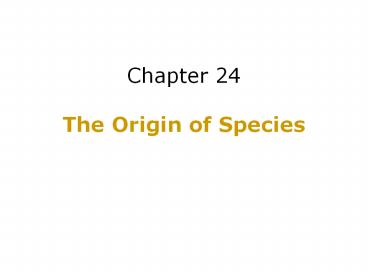The Origin of Species - PowerPoint PPT Presentation
1 / 15
Title:
The Origin of Species
Description:
Accumulation in a population of heritable changes, transforming it into a new species. ... Ex: woman in Argentina and man in Bhutan. human and cow. page 465 ... – PowerPoint PPT presentation
Number of Views:15
Avg rating:3.0/5.0
Title: The Origin of Species
1
Chapter 24 The Origin of Species
2
1- The fossil record chronicles two patterns of
speciation (origin of new species). How would
you characterize these two patterns? Which one
would increase species diversity? Why?
Fig. 24.1
3
SPECIES A
SPECIES B
SPECIES C
SPECIES D
Fig. 24.2
4
2- There are four species in the previous slide.
Why is it difficult to define the concept of
species based on physical traits? How would you
characterize the concept of species? Whats the
justification for your answer?
5
Patterns of Speciation
Anagenesis (up and origin) Accumulation in a
population of heritable changes, transforming it
into a new species.
Cladogenesis (branch and origin) A new
species arises from a population that buds from a
parent species.
Cladogenesis can increase the number of species,
anagenesis cannot.
Fig. 24.1
page 464-465
6
Species (kind or appearance) Biological
species concept Population or groups of
populations whose members have the potential to
interbreed with one another in nature to produce
viable, fertile offspring, but who cannot produce
viable, fertile offspring with members of other
species.
Largest set in which genetic exchange is
possible, at least potentially. Ex woman in
Argentina and man in Bhutan human and cow
page 465
7
3- The concept of biological species depends on
reproductive isolation that is, barriers that
prevent interbreeding and hence genetic mixing.
What do you think are those barriers? How would
you classify them?
8
Prezyogtic (before and yoke) Impede mating or
hinder fertilization of ova.
Postzyogtic (after and yoke) Prevent hybrid
from developing into a viable, fertile adult.
Fig. 24.5
9
To ponder for Thursday Jan 20th Natural
hybridization is common and hybrids are not
uniformly unfit, they are genotypic classes that
are less, equally or more fit than their parental
taxa. Some scientists think that hybridization
could generate biological diversity.
How? Hybridization is common when populations
invade new environments. Why?
Hybrid
10
Limitations of the biological concept of species
1- Impractical for demarcating species, in most
cases. For example, interbreeding in many living
species fossils. Solution assign species based
on morphological and genetic differences.
Tursiops aduncus
Tursiops truncatus
2- Useless for completely asexual life forms. For
example bacteria. Solution assign species based
mainly on structural and biochemical traits.
page 468
11
CONCEPT OF SPECIES
4- With whom do you agree? With whom do you
disagree? Why?
12
A) Ignores the fact that there are individual
variations that are not immediately obvious to
us, such as vocalization in chicks.
13
B) Ignores the fact that there are individual
variations that are immediately obvious to us,
such as in humans.
14
C) Consistent with all available evidence.
15
D) Ignores the fact that there are individual
variations that are not immediately obvious to
us, such as vocalization in chicks.































